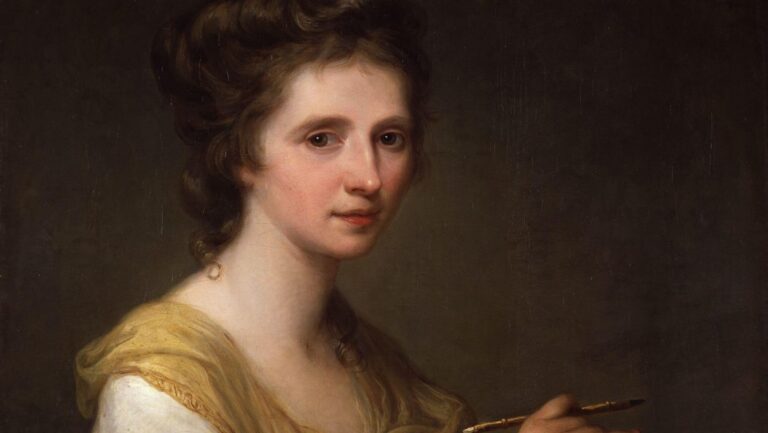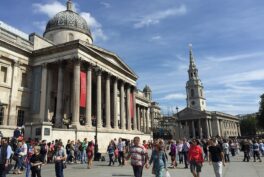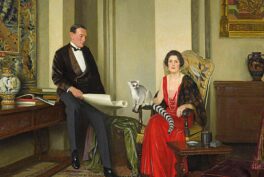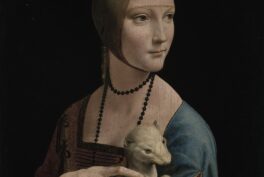The National Portrait Gallery in London is due to close its doors from 29 June 2020. The Inspiring People gallery redevelopment works will take three years. The gallery holds the most extensive collection of portraits in the world. In preparation for this long break, Daily Art Magazine would like to take you for a trip around the world inspired by the works available in the gallery’s extensive online catalog. We’ll visit all continents and meet a host of fascinating people through their amazing portraits.
Given the recent Brexit, let’s look again to Europe. The portraits were selected based on the location in which they were made or on the subject’s relationship to a place.
Romania

This photograph shows friends and contemporaries, Frank Owen Dobson and Augustus John, with Constantin Brancusi (1876-1957), acknowledged as the patriarch of modern sculpture. Brancusi was a Romanian sculptor, painter and photographer who made his career in France. After completing his studies in Bucharest, Munich and Paris he was invited to enter the workshop of Auguste Rodin. However, just after leaving Rodin’s workshop he developed his own unique style that revolutionized the approach to sculpture and influenced many artists.
In addition to being a brilliant artist, Brancusi was also a talented handyman. He built his own phonograph and made most of his own furniture, utensils, and doorways. He always remained closely connected to his roots, even preserving a simple style of dressing characteristic to Romanian peasants. Also, his studio evoked the peasant’s houses from his native region, with a slab of rock as a table and a primitive fireplace. This photograph was probably taken in October 1925 at the opening of the Tri-National Art Exhibition at the New Chenil Galleries in Chelsea, London, which brought together works by leading artists from London, New York and Paris, where Brancusi had his studio.
In 1925 Virginia Woolf published her innovative ‘stream of consciousness’ novel, Mrs Dalloway, which chronicles a day in the life of the protagonist through her interior monologue.
Russia
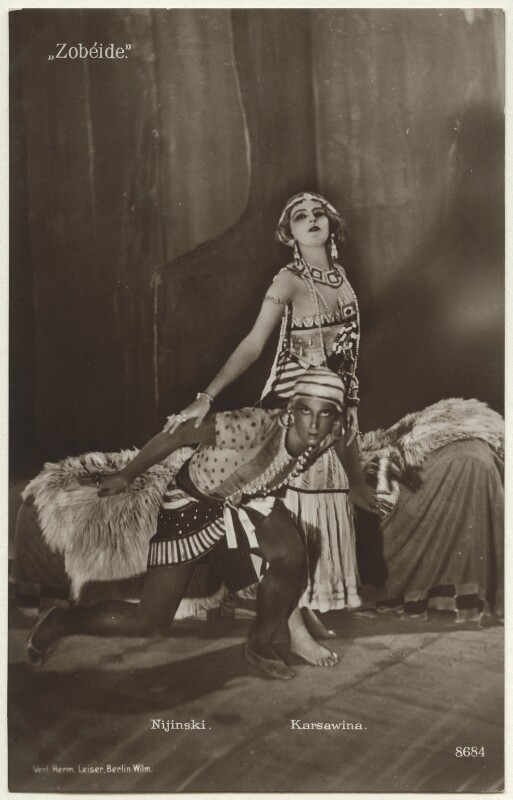
Vaslav Nijinsky (1889-1950) was a Russian-born dancer at the
Ballets Russes. He became a star performer of the company’s Paris seasons. Nijinsky
was celebrated for his virtuosity and for the depth and intensity of his
characterizations. He could dance en pointe, a rare skill among male
dancers at the time and was admired for his seemingly gravity-defying leaps.
In 1912, Nijinsky began choreographing original ballets, including The Rite of Spring (1913) to music by Igor Stravinsky. As you may know, at the premiere of The Rite of Spring, fights broke out in the audience between those who loved this startling new style of ballet and music and those who hated it. People rarely care so much about ballet nowadays.
Unfortunately, Nijinsky’s story has a brilliant start and a tragic ending. In 1913 he married and this caused a split with Diaghilev, who dismissed Nijinsky from the company. Nijinsky tried to form his own company, with no luck. Nijinsky became increasingly mentally unstable due to the stress of having to manage tours himself and being deprived of opportunities to dance. In 1917 the family settled in St. Moritz. After that, Nijinsky’s mental condition deteriorated. He was diagnosed with schizophrenia in 1919 and committed to a mental asylum. For the next 30 years, he was in and out of institutions, never dancing in public again.
Find out more about Nijinsky’s daughter Kyra!
As you may remember, it was in 1912 that our friend from one of the earlier episodes Robert Falcon Scott leads the doomed British Expedition to the South Pole. Captain Oates’ famous last words were immortalized in Scott’s diary: ‘I am just going outside and may be some time.’
That clearly was an interesting year, as the ‘unsinkable’ Titanic stroke an iceberg and went down on its maiden voyage between Southampton and New York.
Hungary
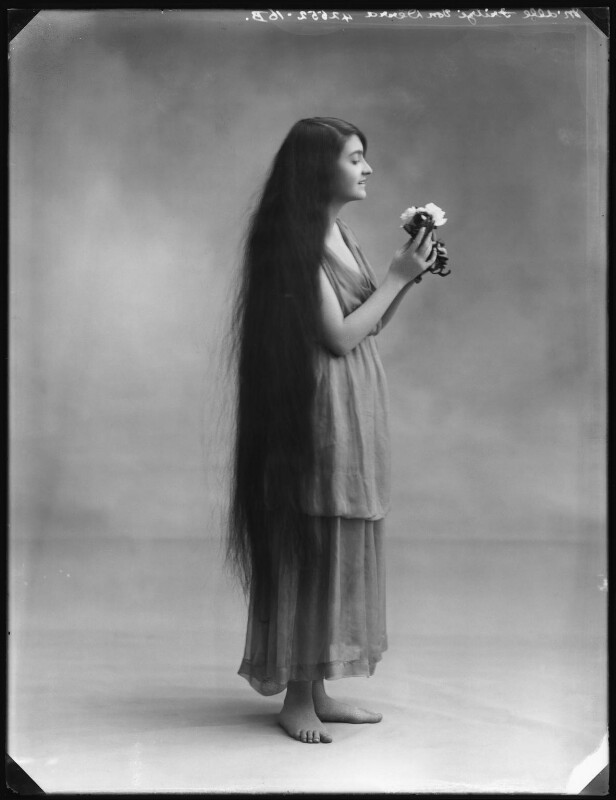
Friderica Derra De Moroda (1897-1978), born in Hungary, Derra de Moroda was a Greek-style dancer. She made her debut at the Vienna Secession in 1912 and afterward toured Germany and Russia as a recital dancer. From 1913 she was based in London, where she appeared in music halls and pantomimes, presenting such works as her Early Victorian Dance and her interpretation of Rubinstein’s Valse Caprice.
In 1918 she opened a dance school in London and later in life became known as a writer on dance notation in the 18th century. From 1960 she devoted herself again increasingly to dance research and built up an extensive library of dance-specific literature. The estate of the Derra de Moroda Dance Archives is open to the public at the Institute of Musicology at the University of Salzburg. On June 15, 1977, she was the first woman ever to receive an honorary doctorate from the University of Salzburg.
Back in 1913, when this picture was taken the Suffragette, Emily Davison dies after stepping out in front of the King’s horse to protest at the Epsom Derby. In the same year, the Liberal government passed the Cat and Mouse Act allowing them to release and re-arrest Suffragettes who went on hunger strike while in prison. Davidson, herself, had been on hunger strike and was force-fed while detained at Holloway Prison.
Also in that year, our well-known friends from the Ballets Russes came to London with Stravinsky’s ballet The Rite of Spring, following its premiere at the Théâtre des Champs-Élysées in Paris. Yet again, the audiences were shocked by Stravinsky’s rhythmic and dissonant musical score and by the violent jerky dancing of Sergei Diaghilev’s Ballets Russes, which were intended to represent pagan rituals.
Spain
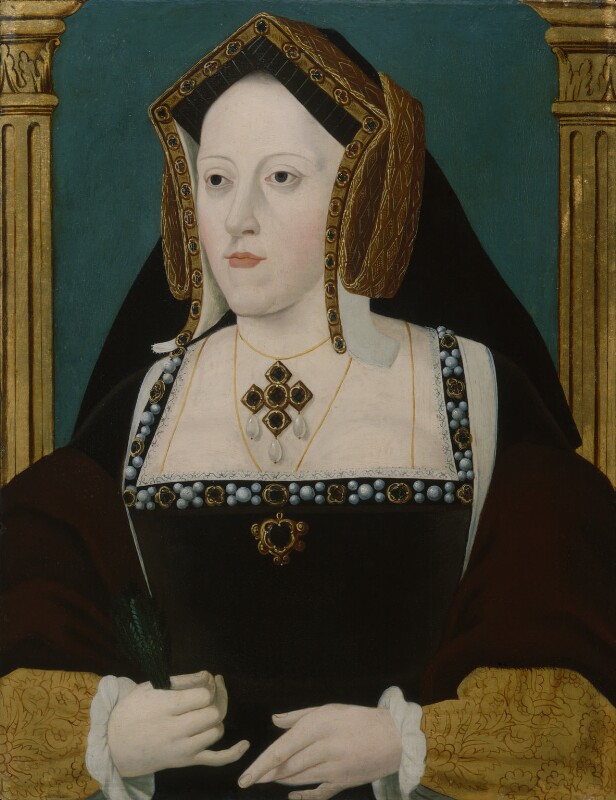
Katherine of Aragon (1485-1536), First Queen of Henry VIII. Katherine was the youngest daughter of Ferdinand of Aragon and Isabella of Castile. She came to England in 1501, aged fifteen, to marry Arthur, Prince of Wales, but only months after the marriage Arthur died. After that, she held the position of ambassador of the Aragonese Crown to England in 1507, the first female ambassador in European history.
In 1509 she married Arthur’s younger brother, Henry VIII. They had five children, of whom only Princess Mary, later Mary I of England, survived. In 1523 she commissioned the book The Education of a Christian Woman by Juan Luis Vives, controversial at its release for arguing that women should have the right to an education. Even her enemy, Thomas Cromwell, said of her, “If not for her sex, she could have defied all the heroes of History.” Katherine died in 1536, firm in her refusal to relinquish her title as queen of England, despite Henry VIII’s annulment of their union and remarriage to Anne Boleyn in 1533.
This portrait of Katherine is a version of a widely-circulated likeness that depicts the queen circa 1530. Technical analysis has revealed that this portrait is not contemporary with the sitter and instead dates from the early eighteenth century, demonstrating a market for Tudor portraits during this period. ‘Prussian blue’, a pigment invented between 1704 and 1710 and only commercially available on a wide scale from the 1720s, was found to be present in the paint used for the background, the jewel of Katherine’s headdress and in the sprig of foliage that she holds in her hand.
Sweden
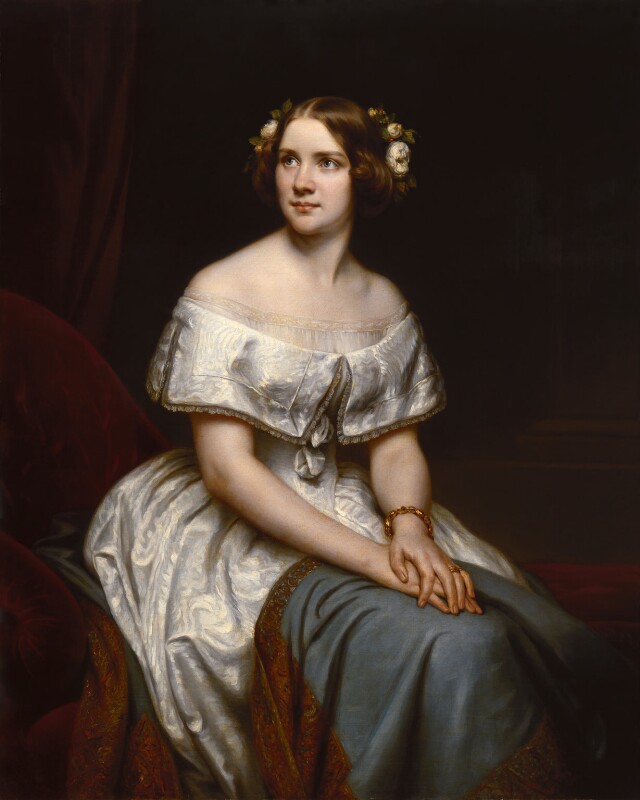
Johanna Maria “Jenny” Lind (1820 –1887) was a
Swedish opera singer, often called the “Swedish Nightingale”. One of
the most highly regarded singers of the 19th century, she performed in soprano
roles in opera in Sweden and across Europe. After two acclaimed seasons in
London, she announced her retirement from opera at the age of 29.
Beginning in 1850 she undertook an extraordinarily popular concert tour of the United States. She was invited by the showman P. T. Barnum. Lind gave 93 large-scale concerts for him and then continued to tour under her own management. She donated the proceeds to various charities, principally the endowment of free schools in Sweden. She returned to Europe in 1852 where she had three children and gave occasional concerts during the following two decades, settling in England in 1855. From 1882, for some years, she was a professor of singing at the Royal College of Music in London.
Switzerland
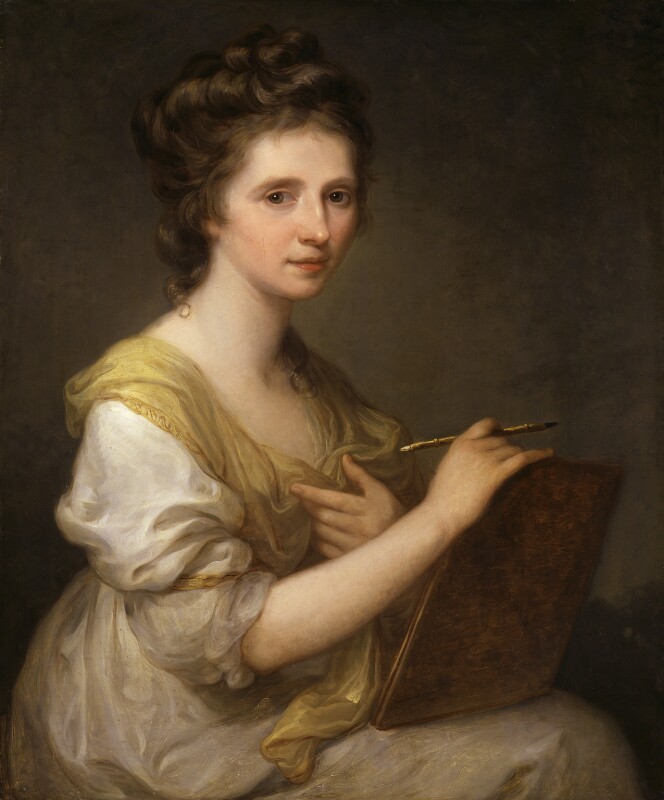
Angelica Kauffman (1741-1807) was an artist of international training and reputation. Born in Switzerland, she was escorted by her artist-father to study the Old Masters in the major Italian cities. Time spent with the English community in Rome convinced her to come to London in 1766 where she joined Sir Joshua Reynolds’s social circle. Her reputation for portraiture and history painting led to her becoming a founding member of the Royal Academy in 1768. Excluded from the life class, Kauffman developed her own brand of history painting which focused on female subjects from classical history and mythology.
In this self-portrait, Kauffman holds a portfolio and ‘porte-crayon’, containing her charcoal. She wears an imaginary, ‘classical’ garment which refers to her place in a lineage of artists. By distancing herself from society and fashion, and depicting herself with the tools of her trade, she makes claims for her principle identity as an artist rather than a woman.
Cornelia, Mother of the Gracchi by Angelica Kauffmann
Turkey
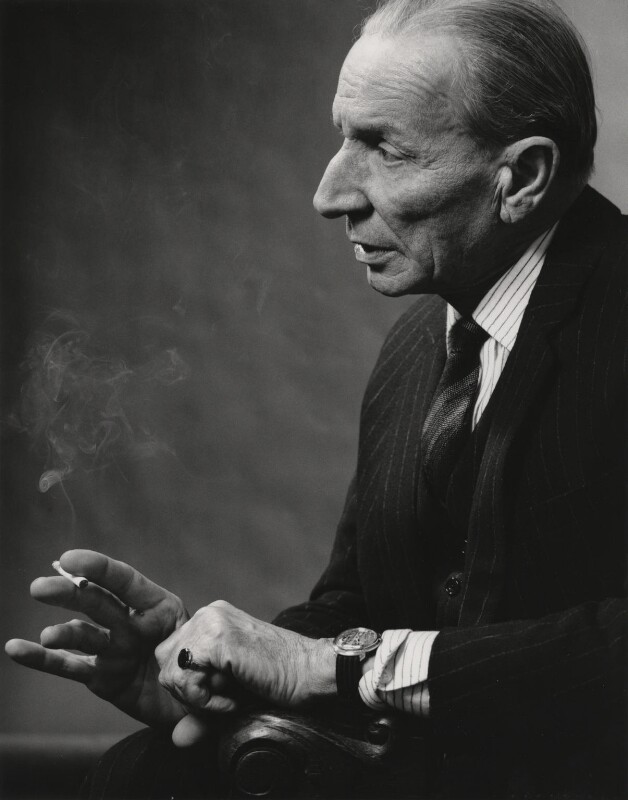
Sir Alec Issigonis (1906-1988) was an engineer. He was the son of Greek and German parents, and inherited British citizenship via his father and developed very “English” attitudes. Because Alec and his parents were British subjects, they were evacuated to Malta by British Royal Marines in September 1922, ahead of the Great Fire of Smyrna and the Turkish capture of Smyrna at the end of the Greco-Turkish War. Following the death of his father in 1922, Alec and his mother moved to the UK in 1923.
Issigonis designed the most enduring small cars of the twentieth century, the Morris Minor (1948) and the Mini (1959) – a testament to his insistence that ‘styled’ cars dated quickly. He became the engineering director of the British Motor Corporation in 1964 and was knighted for services to automotive engineering.
What a year has 1969 been:
The comedy sketch show Monty Python’s Flying Circus is first
broadcast. The Pythons performed surreal sketches that reinvented the comedy
tradition, eschewing punch lines for a stream-of-consciousness structure and
incongruous authorial interventions: ‘and now for something completely
different’.
Neil Armstrong takes ‘one small step for man, one giant leap for mankind’ when he becomes the first man to walk on the moon.
Concorde makes its first supersonic flight. The plane was designed, developed and manufactured by a joint treaty between the French and English governments.
As mentioned in the beginning, in this series of posts we’ll be visiting all continents. Stay tuned for more exciting people whose portraits are in the National Portrait Gallery.
London’s National Portrait Gallery
Around the World with the National Portrait
Gallery – P.1 The Extremes
Around the World with the National Portrait Gallery – P.2 Europe
Around the World with the National Portrait Gallery – P.3 Africa
Around the World with the National Portrait Gallery – P.4 Americas
